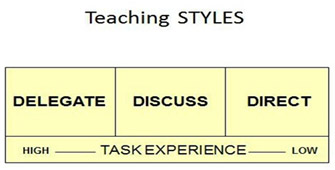Methodology
CBCS Teaching Methodologies
Direct— Tell students what to do
Discuss— Ask questions and listen
Delegate— Empower students
CBCS Teaching Methodologies
- The directingstylepromotes learning through listening and following directions.
- With this style, the teacher tells the students what to do, how to do it, and when it needs to be done
- The teacher imparts information to the students via lectures, assigned readings, audio/visual presentations, demonstrations, role playing, and othermeans
- Studentsgain information primarily by listening, taking notes, doing role plays, and practicing what they are told to do.
- The only feedback the teacher looks for is “Doyouunderstandtheinstructions?”
Suggestionsfor using the directing style:
- Startwiththebigpicture.Provide the context before launching into specifics.
- Beclearandconcise.Students need to know exactly what they must do to succeed and by what criteria their work will be evaluated.
- Providesufficientdetail.Communication breakdowns occur when important details are omitted or instructions are ambiguous.
- The discussingstylepromotes learning through interaction.
- In this style,theteacher encourages critical thinking and lively discussion by asking students to respond to challenging questions.
- The teacher is a facilitator guiding the discussion to a logical conclusion.
- Studentslearn to have opinions and to back them up with facts and data.
Suggestionsfor using the discussing style:
- Preparequestionsinadvance: Ask one question at a time. Be open, curious, and interested in learning what each student thinks.
- Don’tallowoneortwostudentstodominatethediscussion: Solicit everyone’s ideas and opinions. Gently draw out students who seem insecure and reticent to participate.
- Havestudentscreatequestions: Askstudents read a case study/topic andformulate three questions to ask their classmates. We then discuss their answers in class.
- Don’tsugar-coatthemessage: There are times when teachers need to be very direct and candid to get through to students
- Utilizeclickers: Clickers are an easy way to get students involved during class. Pose a multiple-choice question and their responses are tabulated on the screen. You can then open it up for discussion as students share why they selected a certain answer.
The delegating stylepromotes learning through empowerment.
- Withthis style, the teacher assigns tasks that students work on independently, either individually or in groups.
Suggestionsfor using the delegating style:
- Assignresearch projects
- Assignteam projects
- Assigna capstone project.Let students show you what they can do when working independently on a topic that’s important to them
- Use an appropriate mix of each teaching style
- Using an appropriate mix of teaching styles helps students learn, grow, and become more independent
- Too much reliance on one style causes students to lose interest and become overly dependent on the teacher
CBCS - Effective management of large classes
Advantages
- Decreased instructorcosts
- Efficient use of faculty time andtalent
- Availability ofresources
- Standardization of the learningexperience
Disadvantages
- Strained impersonal relations between students and theinstructor
- Limited range of teachingmethods
- Discomfort among instructors teaching largeclasses
CBCS - Teaching Methodologies for Large Group Setting
The traditional passive view of learning involves situations where material is delivered to students using a lecture-based format. In contrast, a more modern view of learning is constructivism, where students are expected to be active in the learning process by participating in discussion and/or collaborative activities.
Suggestions for Constructivism / Active Learning:
- Ask yourself what you want your students to learn and what is the best way for them to learnit
- Plan your lectures and learning activities to achieve the learningoutcomes
- Outlinewhat the lecture is going to cover: use a structure that will encourage you and your students to engage in active learning with clear aims and learning outcomes showing what students will know, understand or be able to do by the end of thesession identifyand repeat your keymessages
- Encourageand build in time forquestions
- Allow time for students to reflect on what they’ve learned

